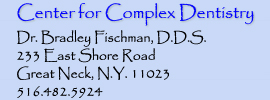 |
 |
Drs. Kahn, Tallents, Katzberrg, Ross, and Murphy, in their article “Prevalence of dental occlusal variables and intraarticular temporomandibular disorders: Molar relationship, lateral guidance, and nonworking side contacts” (J Prosthet Dent 1999;82:410-5) compaired the occlusal relationships of four groups of patients. (1) asymptomatic with no MRI evidence of a displaced disc, (2) asymptomatic with MRI evidence of adisplaced disc, (3) symptomatic with no MRI evidence of a displaced disc, and (4) symptomatic with MRI evidence of a displaced disc.
The results suggest that symptomatic patients have an increase in Class II Division I molar relationships. More interesting is the predominance of group function on both sides by the asymptomatic patients. On the right side, there was a greater incidence of cuspid rise in the symptomatic patients with displaced discs. All symptomatic patients had less nonworking side contacts than the asymptomatic patients.
This study viewed in conjunction with the electromyographic studies that demonstrate increased muscle activity during closing in group function vs. cuspid rise occlusion, supports the thought that there is no direct relation between a patient’s occlusal pattern and TMD. There may be a relationship between asymptomatic patients and having a greater number of contacts in lateral excursions. It may therefore be contraindicated to arbitrarily change an asymptomatic patient’s occlusal pattern to cuspid rise.
Dentures | Extreme Makeovers | Doctor's Credentials | Map & Policies | Contact Us
Home | Professional Referrals | Tidbits for Dentists | Newsletters for MDs